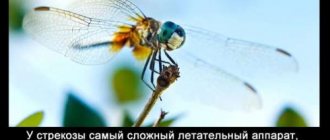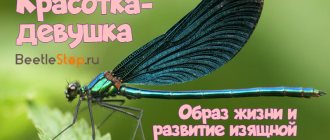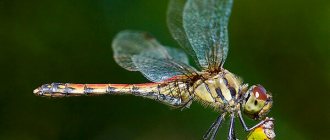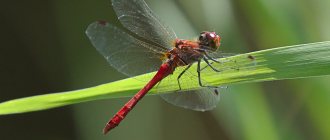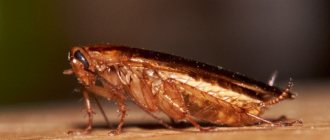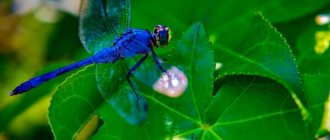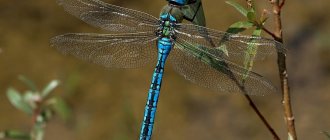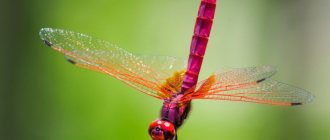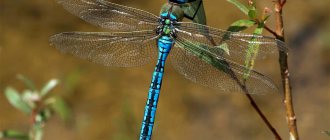- Wild animals
- >>
- Insects
The dragonfly is an arthropod insect with six legs, belonging to the subclass of winged insects, the order of dragonflies. The order of dragonflies currently includes more than 6,650 species of these insects. Dragonflies are fairly large predatory insects that have a movable head, large eyes, a long and slender abdomen and four transparent wings. They are found all over the world, with the exception of cold Antarctica.
Origin of the species
Dragonflies are an ancient group of arthropods. The first dragonflies lived on the planet back in the Carboniferous period during the Paleozoic era. The origin is related to the giant dragonfly-like insects Meganeura. Those, in turn, were large arthropods with a wingspan of up to 0.66 meters. They are considered the largest arthropods of that time. Subsequently, it was they who became the descendants of Kennedyina, Ditaxineurina, living already in the Triassic period of the Mesozoic. These arthropods were also distinguished by their large size, with a span of up to 90 mm. When the animals rested, the wings were hidden under the abdomen.
Meganeura
In those days, insects had a well-developed trapping basket. They used it to grab victims. The next descendants of Meganeura living in the Jurassic period are Lestomorpha, Libellulomorpha, the larvae of which are capable of developing in water. Their aircraft has changed significantly, becoming more advanced. The descendants of meganeurinids gradually settled throughout the planet.
At this time, the descendants of the superfamily Calopterygoidea changed dramatically. Their wings became narrower and evened out in size. The Cretaceous era carried away many suborders of insects, and in the Cenozoic era modern suborders of dragonflies can be seen. In the Neocene, dragonflies ceased to differ from modern ones.
From the depths of millennia
Three hundred million years ago there were no birds on Earth and giant dragonflies reigned in the air. One of them was Meganeura. Its wingspan reached 70 cm, like a large modern pigeon. Meganeura hunted other insects, which were also quite large. Today, the wingspan of the largest dragonfly living in South America barely exceeds 19 cm.
The ancient dragonfly Meganeura was the size of a large modern bird
Description, appearance and features
These insects are easy to distinguish from other arthropods with the naked eye. At the same time, the color of animals can vary dramatically. The most expressive parts of the insect's body are:
- Large head with expressive eyes.
- The body is brightly colored, sometimes shiny.
- Chest part.
- Transparent wings of various shades.
Dragonfly: appearance
Depending on the species, animals come in different sizes. The smallest dragonflies are considered to be up to 1.5 cm long. The largest representatives grow up to 10 cm. The large head can rotate 180 degrees. Large eyes consist of thousands of ommatidia, whose number can vary from 10,000 to 27.5 thousand.
It has been proven that the lower ommathia reproduce only colors, while the upper ones determine the shapes of objects. This feature allows dragonflies to perfectly navigate in flight and catch prey. On the crown of dragonflies there is a small swelling on which three additional eyes are located. Dragonflies also have awl-shaped antennae, they are short and consist of approximately four to seven segments.
Dragonfly eyes
Interesting fact : dragonfly eyes have a complex structure.
They consist of 30 thousand ommatii, capable of instantly orienting themselves in space. Powerful jaw apparatus formed by unpaired lips. In this case, the lower lip consists of three blades covering powerful jaws. The upper lip, in the form of a small plate stretched across, covers the upper jaw. The insect is able to catch and chew food during flight due to the difference in size of the upper and lower lips.
Interesting fact : dragonflies hunt other insects and avoid collisions thanks to a viewing angle of almost 360 degrees.
The thoracic part has three sections: anterior, middle, posterior, with a pair of limbs on each. The last two sections also contain the wings of the animal. The anterior section is separated from the middle, which together with the posterior section are fused together, forming a synthorax, which is perceived as a chest.
Structure of a dragonfly
The chest is flattened on the sides, and the dorsum is slightly pushed back. The middle part of the chest is higher than the back, so the wings are intertwined behind the legs. The front part of the backrest is divided into three sections. There is a dent on the middle one. The segments on which the wings grow are hypertrophied pleurites.
Interesting fact : dragonflies are resilient. Red tramps are record holders for migration. They cover enormous distances during flights - more than 6.5 thousand km.
The wings of dragonflies are practically colorless and consist of a pair of layers of chitin formed by a venation system. The veins are superimposed on each other in such a way that they appear to be a single network. The system is complex and dense, each order of dragonflies has a unique network of veins on their wings.
Interesting: Why do mosquitoes bite and why do their bites itch? Description, photo and video
Dragonfly wings
The abdomen of dragonflies is round and elongated. Some species have a flat abdomen. In all species, the abdomen is the largest part of the body. The abdomen is divided into 10 segments. On the sides of the abdomen you can see pleural membranes, which allow the insect to bend.
On each segment, in addition to the last two, there are sigmas. At the tip of the abdomen are anal appendages, the number of which varies between females and males. Females have two, and males have three to four. The genitalia of females are located at the end of the abdomen, while in males the organ of compilation is located on the second abdominal segment. The opening for the release of sperm in males is located on the tenth abdominal segment. Insects have strong and well-formed limbs, consisting of the femur, pelvis, tibia and leg parts with paws. Each leg has spines.
How to distinguish between male and female dragonflies?
Male and female dragonfly
Insects are characterized by sexual dimorphism. These are external differences between males and females, which are clearly noticeable especially in dragonflies. Dimorphism is important for dragonfly reproductive behavior. Surprisingly, the color of insects changes throughout life , the final establishment of color is noted at sexual maturity.
There are different types of sexual dimorphism in dragonflies. Some species are distinguished by large females and small males, while for others the opposite is true. Insect families also show certain trends in dimorphism. The beauties are distinguished by large males, and the shooters are distinguished by large females. The color of individuals is considered an important sign of sexual dimorphism. The pattern on the wings is also a sign of gender.
Sometimes insects exhibit polymorphism, that is, the presence of certain forms of one species that differ in color. In such cases, color is not associated with dimorphism.
Habitat – where does the dragonfly live?
Dragonflies are distributed throughout the world. The only place where dragonflies cannot be found is Antarctica. Most species are found in the Indo-Malayan region. There are approximately 1,664 species of animals found there. There are 1,640 species common in the neotropics, 889 in the Afrotropics, and 870 species in Australia and the region. Temperate areas are home to fewer species. This is because insects prefer warm, moist conditions.
Eggs are laid in water reservoirs and rivers. Depending on the variety, they are particularly sensitive to the choice of breeding site. Dragonflies Pseudostigmatinae prefer small water reservoirs, while other species can only breed in rivers or large lakes. The larvae are constantly in the water and can stay there for up to two years. Individuals that have learned to fly gradually fly away from their place of birth over long distances, migrating.
Horseflies
Horseflies are considered very fast flying insects, capable of reaching speeds of up to 60 km/h during mating. Horseflies inhabit all continents except Antarctica. They are also absent from Iceland, Greenland and some oceanic islands. The largest number of horse flies, both in numbers and in the number of species, are found in wetlands, on the boundaries of different ecotopes, and in areas of livestock grazing. Their number only increases from the proximity of humans.
Habitat
Dragonfly habitat
Insects prefer warm zones, and spread in those areas where negative temperatures are not maintained for more than three months a year. The lifestyle of animals is amphibiotic, that is, the offspring are raised in water, and adults live in the ground-air environment.
Dragonflies are fast and easy to maneuver. The air is considered their home. Having occupied certain territories, dragonflies will defend them from enemies to the last, even from their relatives.
Lover of clean water
The flat-bellied dragonfly is so named due to its flattened and wide abdomen. By striking the end of her abdomen against the surface of the water, the female lays eggs. For this purpose, she prefers reservoirs with stagnant or low-flowing water. For the flat dragonfly, water purity is very important. And since the number of suitable places for its habitat has been rapidly decreasing in recent years, the flat dragonfly is listed in the Red Book.
"Clean" flat-bellied dragonfly
How long do dragonflies live?
Insects live for several months. Moreover, the entire development of dragonflies takes more than one year. The larvae that hatch under water live there from several months to four years. They evolve, hunt and hide from enemies. Gradually, dragonflies molt and grow, learning to fly. Adults leave water bodies and begin migration.
Dragonflies are special insects. They do not require pupae or cocoons to develop into adults. After emerging, the adult dragonfly dries out from the water for some time and begins its flight. A few hours after growing up, dragonflies begin hunting winged insects, gradually adapting to new conditions. At this stage of development, the insect is greatly influenced by the surrounding temperature and climate. In warm conditions without precipitation, dragonflies live up to six months, but in cold conditions they survive for several weeks.
Interesting: Mosquito: description, nutrition, habits, why they bite, reproduction, types, photos and videos
What does a dragonfly eat?
Dragonfly with prey
Dragonflies are predators, so they feed on most airborne insects. Their diet mainly consists of midges, mosquitoes, various flies, and arthropods. In the larval stage they eat small fish or their own kind.
Subspecies are divided according to hunting method:
- Free hunters fly high. They have strong, developed wings that allow them to maneuver on the upper tiers. Sometimes they hunt in a flock, but most often they hunt completely alone, flying at a distance of two to nine meters .
- Free flying, hunting in the territory of the middle tier. They do not fly over the two-meter high . They constantly look for food, sometimes resting on plants.
- Lying in wait - they hunt from ambush, waiting for prey.
- Dragonflies also live in the lower tier. They hunt in grass thickets, catching insects on plants. They feed while sitting on the grass, not in flight.
Bee
The list of the fastest insects in the world rightfully includes the bee . The bee's flight speed is 65 km/h, which is approximately the same as the speed of a car in the city. In one flight, a bee collects almost as much nectar as it weighs. With a full honey ventricle, a bee can reach speeds of up to 30 km/h. To collect 1 kg of nectar, a bee will have to make up to 150 thousand flights from the hive. On average, a bee travels up to 3 kilometers in one flight. To produce a kilogram of honey, a bee needs to fly an average of 450 thousand kilometers. This means that the distance a bee flies is similar to the distance it would take to circle the Earth's equator approximately 10 times.
Features of character and lifestyle
Dragonfly
In Russia, dragonflies are found from mid-spring to mid-autumn. In warm regions, insects are found throughout the year. Insects are diurnal, being more active on warm sunny days.
In the mornings, dragonflies bask in the sun, resting on stones, grass or trees. At noon, they assume a “reflection” position, reflecting the sun’s rays with the tip of their abdomen. Thus, the animal does not overheat. Hunting takes place in the evenings and mornings. The species is more active during dawn. At night, dragonflies rest alone in the thickets.
Social structure and reproduction
Life cycle of a dragonfly
Animals experience three processes of transformation: egg-larvae-imago, that is, adults. Dragonflies lay eggs several times a year. Mating occurs on the fly, males perform mating dances, showing various things in the air. One clutch contains up to 500 eggs. Only a few survive without being killed by fish or birds.
The larvae become adults only after a year, sometimes the process drags on for several years. The size of the new larvae is approximately 1 mm, molting begins almost immediately, they feed on their own and hunt underwater.
Fun fact : Certain species lay their eggs in salt water. Dragonflies are exceptional insects capable of living in the ocean.
Predator or herbivore?
The dragonfly is a predatory insect, and an active one at that; it hunts directly in the air, catching insects. In order to make it clearer what a dragonfly eats in nature, you will need to carefully consider its structure, which directly indicates the type of nutrition of this insect.
- The dragonfly's eye has a faceted structure, and its thin neck allows it to move its head - this improves visibility during the hunt and allows it to detect and track potential prey. The viewing radius reaches eight meters.
- The strong jaw is designed for cutting up caught prey; a dragonfly can gnaw and crush even the hardest chitin.
- To hold large insects, the dragonfly has tenacious limbs, and is able to catch very small animals immediately with its mouth in flight.
- The elegant and graceful body of the dragonfly allows it to maneuver beautifully and effectively in the air; it plots its flight path in such a way as to increase the efficiency of its hunting. It is difficult for even such dexterous insects as flies and midges to fly away from a dragonfly - it is a very fast predator.
Thus, the answer to the question of what dragonflies eat is becoming more and more obvious - it is a rather aggressive insect that hunts smaller individuals.
Types of dragonflies
These insects can be found all over the planet, so they are very diverse in appearance and structure. Some species of dragonflies are studied only from finds in a particular area, and some have become known thanks to single specimens. A significant part of the species has not yet been studied by researchers. In 2013, there were 6,650 species of dragonflies in the world, along with 608 fossils. Every year the number increases by several dozen. Over two years of research, the number of living species increased to 5,899.
Graceful arrow
Graceful arrow - dragonfly
They live on the European part of the continent. Small in size - up to 3.5 cm and with a thin elongated abdominal part. The wings are transparent, the limbs and body are black with a characteristic pattern of blue, black or green-yellow shades.
Beauty girl - dragonfly
Beauty girl - dragonfly.
Male (right) and female Relatively large insects, up to 50 mm long. Males are bluish or metallic in color, females have smoky transparent veiny wings. They are most often found in Asia, less often in southern Siberia.
Interesting fact : dragonflies tear off the wings of their victims, making it impossible for them to escape. At the same time, dragonflies are not capable of harming people due to the fact that they cannot bite through the skin.
Lyutki
Dragonfly from the family: Lutki
Lutki dull - common in the European part of Russia. They mainly settle in shallow waters and have a metallic greenish coloration. Can be of various colors and types.
Fun fact : Dragonflies are excellent fliers. Only a few insects on the planet can compete with dragonflies in the beauty of flight. Two pairs of wings are designed so that they can move independently of the others. Dragonflies can suddenly change direction of flight within a fraction of a second.
Dedka ordinary
The common damsel is a dragonfly, a male
dragonfly is of medium size - no more than 50 mm. With large green eyes and a chest painted with black oblique stripes. The chest is yellow, the abdominal part is black with small yellow spots on the sides. Distributed in Central Asia and the South Caucasus.
Interesting fact : dragonflies can live underwater for two years. The insects lay their eggs underwater, and the hatched offspring can spend up to two years there. They adapt to underwater life, learn to hunt and hide from enemies. Dragonflies can also feed on the larvae of their own kind.
Flatbellies
Flat-bellied dragonflies
Flat-bellied dragonflies are a fairly common family of dragonflies of various colors. Most often, dragonflies are brownish-yellow with green or blue stripes, sometimes with reddish patterns.
Interesting fact : There are dragonfly sanctuaries all over the world. Since human activity has a detrimental effect on insect populations, protected areas have been designated. The first such reserve opened in Britain in 2009.
Flying yoke
Although the large rocker dragonfly is not the largest in the world, it is not called large for nothing. Its length reaches 73 mm. It is not difficult to meet such a large dragonfly - from May to September it flies around its hunting grounds. And the rocker has a lot of them, because they live throughout Europe, in Transcaucasia, right up to Lake Baikal, in Siberia and Central Asia. Truly an omnipresent rocker!
The body shape of this insect really resembles a rocker
Population and species status
Blue Dragonfly
Dragonflies are distributed throughout the globe. As of 2013, there were approximately 6,650 animal species on the planet. At the moment, the figures have increased significantly. Researchers are constantly finding new species. However, at the moment, some species of dragonflies may disappear forever. This occurs due to constant human pollution of the environment.
Interesting: Wasp
